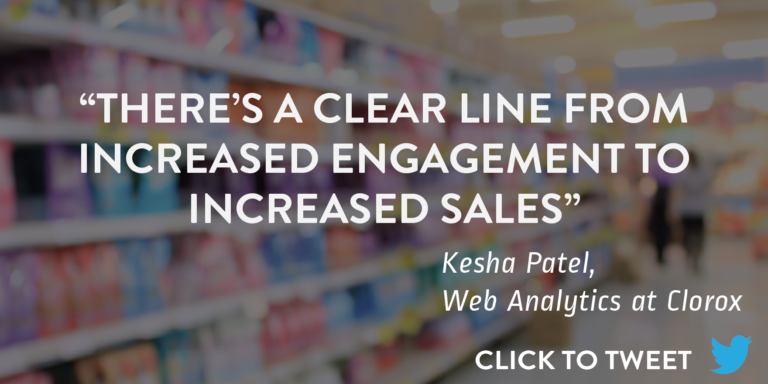How Clorox uses analytics to innovate
A quick Silicon Valley success story: a few years back, five Bay Area venture capitalists invested $100 each in a consumer packaged goods startup called “The Electro-Alkaline Company” that they believed was set to disrupt the garment cleaning industry. Clunky name aside, they saw a product that would radically change people’s lives at home, extending the longevity of their clothes by years and rendering previously unwearable garments as good as new at an unbeatable price.
The product worked. It was an improvement on centuries-old technology, and savvy management helped grow the business and make it more affordable for consumers than it ever had been before. In 1928, after fifteen years of growth and a name change, Clorox went public and has been a leader in consumer packaged goods ever since. Those five investors most certainly got their $100 worth.
Point being: Clorox has been around a while. Over the years, Clorox has expanded its portfolio. It’s not just a bleach company—other assets include Hidden Valley Ranch, KC Masterpiece, Fresh Step, Burt’s Bees and others. Clorox has adapted to everything that has happened since its founding in 1913, and it’s not afraid of the digital transformation that it knows it needs to make—or rather, is making—to continue growing. Historically, Clorox’s products have been sold primarily in big box stores, and though that is still the case, the company has seen double-digit growth in its e-commerce business in each of the past two years—a trend that Web Analytics Group Manager Kesha Patel is responsible for maintaining. That’s why she–like those five initial investors in Clorox–bet big. Kesha, part of a cross-functional team of data scientists, developers, analysts and product experts, had the goal of increasing the engagement of their best customers on the website of one of their brands. The team saw success. Their efforts spurred a 30% increase in engagement, and now they have a powerful tool that can be deployed across their portfolio. Here’s what they built and how they did it.

Being on top isn’t good enough
When you’re already a market leader, innovation may not come as easily, but it can bring big rewards. “We don’t want to lose relevance,” Kesha said. “We can’t just rest on our laurels and be happy with being the market leader. Every aspect of our business, including the website, should serve a clear purpose.”
So here’s the question she needed to answer: what should a CPG company’s website, you know, do?
The good news: Clorox’s wide variety of brands and forward-looking leadership allowed for more experimentation than would be possible at other companies. The bad news: it was quickly apparent that the most obvious idea of what to do with these websites was not going to be a feasible solution.
“We don’t really get sales from our site. It’s not something we do, and if we approach the website as a sales portal, we’re setting ourselves up for failure,” Kesha said.
Instead, they would have to use the websites as places where users engaged with content related to the products and developed brand loyalty. To that end, they decided to run an experiment with the Hidden Valley Ranch site. The test: will a personalization engine increase retention and engagement on the website? And what would that look like?
Kesha knew there were two metrics that she really cared about. “We decided to focus on retention and engagement. Could we get consumers to visit one more page? Could we get them to return to the site again? Are we seeing them become registered members of our rewards program?”
Building the engine
The personalization engine they built was not a massive overhaul of the website, but a few simple adjustments. Instead of the same hard-coded recipe recommendations on specific pages going to everyone, viewers would now see recommendations based on what pages they had previously visited. The goal was modest and ambitious at the same time. It sounds simple enough, but first, they needed someone who could build an algorithm to power the engine.
Fortunately, Naveen Kolagatla, a Data Scientist, was more than capable. He knew where to start: “We needed to track and collect both registered and anonymous user data on our site.” It took Naveen four months to design an algorithm based on their data that would effectively tailor individual experiences and recommendations within the site.
The process required Naveen to not just take in data, but to interpret it with the kind of complex analytics that serve as the backbone of any personalization engine. “We built statistical models to dig deep, and saw the evidence suggesting that personalized recommendations would delight our customers.”
And Naveen couldn’t do it alone. “We realized personalization was a team sport,” Naveen told us. “We had tagging/analytics, developers, creative development, copywriters and brand folks working together to make this happen.”
Kesha agreed: “If we were going to do this project, it was imperative that we track the results to make sure we were spending time and money wisely.”
Personalization pays off
“We ran an A/B test beginning of this year,” Naveen said. “Our results were positive. Consumers who received the personalized experience viewed and engaged with recipes 3x more than consumers who received the static experience. A more surprising aspect of this test was consumers were organically exploring a wider variety of recipes after being exposed to personalized test.”
After launching with a personalization engine that only targeted return users, the lift was undeniable. Think of the person you know who loves ranch dressing the most. Imagine them slathering it all over all of their favorite foods: pizza, salads, burgers, everything. It’s fair to say that people making repeated visits to a ranch dressing website are these kinds of people. These are the people Hidden Valley Ranch needs to reach–the one percent of the one percent of ranch dressing consumers. And Hidden Valley Ranch’s personalization engine was able to hold their attention and keep them actively engaged on the site for longer. Time and time again, they found the suggestions from the personalization engine to be delightful.
What’s next?
“The lessons of the Hidden Valley Ranch personalization engine experiment transcend the brand,” Kesha said. “If we can serve content that consumers are interested in, they will engage with it. And there’s a clear line from increased engagement to increased sales.”

But it takes careful preparation and work. Kesha was clear about one thing: if you want to have a personalization engine, you need the data upon which you base your underlying assumptions to be good.
“I think so many companies struggle with data integrity–trusting that what they are looking at is accurate. Because if that foundational data is not accurate, then what is a team supposed to do? Make sure you do things right the first time, otherwise you have to reimplement and instrument everything differently.”
Naveen agreed: “Follow the data! Start with small tests and scale big after you see the value.”
Kesha was excited about the potential for the personalization engine. “There is no shortage of brands that Clorox can use it on. Burt’s Bees, Kingsford, Soy Vay, Formula 409 and Fresh Step all represent exciting opportunities. We’re looking at it now, but it’s something you’re going to see rolled out across our brands in the future.”
It’s a future the Electro-Alkaline Company never could’ve imagined.


